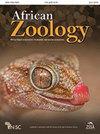喀麦隆西部热带环境变化中蝙蝠(哺乳动物:翼手目)的多样性模式
IF 0.5
4区 生物学
Q4 ZOOLOGY
引用次数: 2
摘要
喀麦隆西部地区是撒哈拉以南非洲地区主要的农业生产区之一,这种持续的人为干扰导致自然森林被农业生态系统所取代。这种人为的景观变化可能影响了该地区蝙蝠的种类组成和丰度。我们的研究评估了蝙蝠组合对这些变化的响应,通过比较该地区四种不同栖息地类型的物种多样性和丰度:耕地(转化景观)、稀树草原和廊道森林(均代表退化地区)和次生林。采用地面雾网共捕获25个品种442只。蝙蝠物种丰富度最高的是人工养殖场(13种)和丰富度(145只),最低的是廊道林(6种)和丰富度(62只)。安哥拉短爪虫相对丰度最高,养殖场捕获数量较多。从秩-频率图中可以看出,在人工养殖场(赤池信息准则(Akaike’s Information Criterion, AIC) = 53.7)、廊道林(AIC = 27.7)和次生林(AIC = 48.5)中,蝙蝠种群的分布符合优先模型,而在大草原(AIC = 40.0)中,蝙蝠种群的分布符合零模型。广义线性模型显示,四种生境类型的物种和相对丰度存在显著差异。本文章由计算机程序翻译,如有差异,请以英文原文为准。
Diversity Pattern of Bats (Mammalia: Chiroptera) in a Modified Tropical Environment in the Western Region of Cameroon
The western region of Cameroon is one of the leading agricultural production areas in sub-Saharan Africa, and this ongoing anthropogenic perturbation has led to the replacement of natural forests with agroecosystems. Such anthropogenic landscape transformations may have affected bat species composition and abundance in the area. Our study assessed the response of bat assemblages to these changes, by comparing species diversity and abundance across four distinct habitat types within the region: cultivated farms (transformed landscape), savannah and gallery forest (both representing degraded areas), and secondary forest. A total of 442 individuals assigned to 25 species were captured using ground-level mist nets. The cultivated farms recorded the highest bat species richness (13 species) and abundance (145 individuals), whereas the gallery forest had the lowest species richness (six species) and abundance (62 individuals). Myonycteris angolensis had the highest relative abundance in the region, with large numbers captured in cultivated farms. According to the rank-frequency diagram, bat assemblages in cultivated farms (Akaike's Information Criterion (AIC) = 53.7), gallery forest (AIC = 27.7), and secondary forest (AIC = 48.5) are distributed according to the pre-emption model, whereas the distribution in the savannah (AIC = 40.0) follow the null model. Generalised linear models revealed significant differences in species and relative abundance across the four habitat types.
求助全文
通过发布文献求助,成功后即可免费获取论文全文。
去求助
来源期刊

African Zoology
生物-动物学
CiteScore
2.60
自引率
9.10%
发文量
18
审稿时长
>12 weeks
期刊介绍:
African Zoology , a peer-reviewed research journal, publishes original scientific contributions and critical reviews that focus principally on African fauna in terrestrial, freshwater, and marine ecosystems. Research from other regions that advances practical and theoretical aspects of zoology will be considered. Rigorous question-driven research in all aspects of zoology will take precedence over descriptive research. The Journal publishes full-length papers, critical reviews, short communications, letters to the editors as well as book reviews. Contributions based on purely observational, descriptive or anecdotal data will not be considered.
The Journal is produced by NISC in association with the Zoological Society of South Africa (ZSSA). Acceptance of papers is the responsibility of the Editors-in-Chief in consultation with the Editors and members of the Editorial Advisory Board. All views expressed are those of the author and not necessarily those of the Editors or the Department.
 求助内容:
求助内容: 应助结果提醒方式:
应助结果提醒方式:


